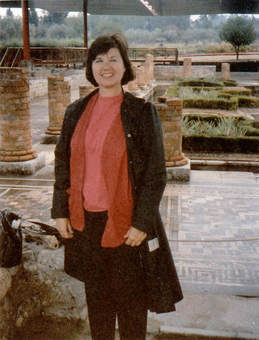 Sherrill at Roman site in Portugal
Sherrill at Roman site in Portugal Spies, refugees, secret agents crept through our room at the Avenida Palace hotel in Lisbon. That's what we were told by the elderly mustachioed porter as he set down our bags. The old hotel stood next to the nineteenth century Rossio train station. Our room was on a narrow sixth floor extension that connected the hotel to the station's side wall. The porter claimed that before and during World War Two it had been a secret passage through which desperate people had slipped from and to the railway station, hoping to begin a journey to safety. Any door that existed between our room and the Rossio station was long gone, although Sherrill tried to find it.
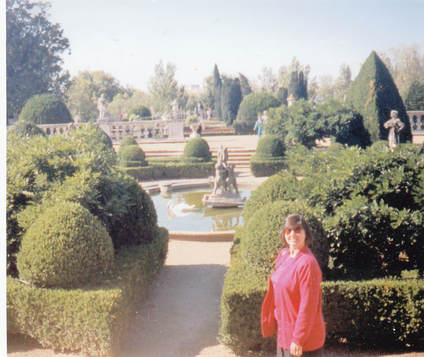 Sherrill in Lisbon Garden
Sherrill in Lisbon Garden Gypsy women draped in black were the only beggars that we encountered, but they were relentless, pursuing us, pushing against us, hands everywhere. They didn't get anything off us, but they certainly tried. Several times, we climbed up to the Alfama, or Old Town, wandering along the narrow twisting streets between buildings that seemed ancient, but that must have been built after the earthquake. From time to time, we stopped at half-hidden little squares and small restaurants, sometimes hearing the deep-throated, anguished strains of fado, the songs of Portugal. I wanted to return at night for a full show, but Sherrill didn't enjoy fado—for much the same reason that she didn't care for the songs of Edith Piaf, the emotions they evoked were too raw, too tragic. The Lisbon Botanical Gardens, especially the huge greenhouse with its enclosed jungle of giant ferns and oversized blossoms, were more to her taste.
"Caldo verde," one woman told us, was her favorite typical dish: a thick soup of potato, shredded kale, and hunks of spicy sausage. A man we talked with preferred the stews made from dried salt cod, a dish that evolved from seafaring days. I rather liked some of these hearty dishes because of their rich flavors, but Sherrill preferred simple seafood meals, grilled sardines, octopus, and shrimp—always with a salad. And Portuguese wine.
Hiking along the Tagus river, we came to the area where the 16th century explorers set sail and the monument to those brave adventurers. We even looked in at the chapel where Vasco de Gama is said to have spent the night before he left on his historic voyage. It's easy to understand why the Portuguese became a people of explorers, with the restless sea lapping at their long coast, enticing them with promises of adventure and riches.
After a few days exploring Lisbon, we took a cab to a rental car agency atop one of the hills. An attendant brought out the car we'd reserved, left it on the concrete slope descending to the street, and walked away as Sherrill started to slide into the driver's seat. Suddenly, the car began rolling. He'd forgotten to put on the brake. I managed to stop it with my shoulder, then Sherrill found the emergency brake and the man ran up, shouting apologies. Now, all she had to do was navigate those twisting narrow streets until we got out of the city.
"The drivers here are insane!" Sherrill announced, as if she was afraid I hadn't figured that out, myself.
Not only did they speed, but were wildly erratic, changing lanes, crossing in any direction without signaling, suddenly slowing down, then speeding up again. Each driver seemed to exist in a private universe, unaware of anyone else on the road.
"Don't talk while I'm driving," Sherrill warned me, "if you want to live."
The historic town of Sintra, dramatically poised above the Atlantic between two gorges, was only a short picturesque drive from Lisbon. The first signs of the town were an 11th century Moorish castle and, nearby, a more eccentric palace, part Gothic and part Moorish, topped by a pair of enormous conical brick chimneys. As we wandered through the country, we discovered many oversized, fantastic castles and palaces. Because of its colonies, Portugal once was the richest country in Europe and for a while was busy spending that fortune, especially on gigantic building projects. Near Sintra, we found an enormous palace-monastery, even bigger than Philip II's elephantine complex in Spain and almost as depressing.
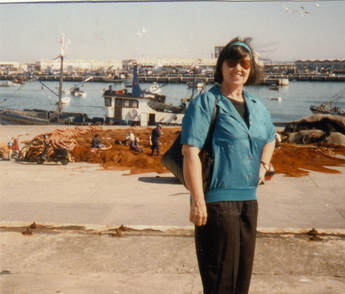 Sherrill at Port of Peniche: men repairing fishing nets
Sherrill at Port of Peniche: men repairing fishing nets "This is more like it."
As if we had all the time in the world, we strolled along, watching fishermen repair bright orange nets spread on the beach front, then stopped at small inexpensive cafe where a one-armed old man and a teenage girl brought us a meal of freshly caught octopus and sardines.
"I feel like Charles Laughton in The Beachcomber."
"Darling, you're lucky I know what you're talking about. Most people wouldn't."
"Too bad you missed it, you silly boy" she said, when she came out. "It was quite a spectacle—even waxwork figures of the children and Saint Fatima...."
Although it was out of our way, Sherrill wanted to see Tomar, one of the oldest cities in Portugal, known for the beautiful convent and sixteen-sided church built inside the walls of a Templar castle and where Prince Henry the Navigator launched the Age of Discovery. The castle, the religious buildings, all were beautiful and fascinating in their way, but in my memory Tomar will always be the town with the museum of the world's largest collection of match boxes: room after colorful and crazy room of carefully arranged match boxes.
Portugal's second city, Porto, we decided, was as beautiful as Lisbon, as it climbed steep hills on both sides of the Tagus river.
"And this is where we learn about port," Sherrill reminded me.
"Is there that much to learn?"
"You'll see."
On the side of the river across from the main city, we found more than a dozen bodegas where different varieties and brands of port were created. Most of them had been there for many generations. During our days in Porto, we visited and tasted at several, toured a few, and especially enjoyed two, Sandeman (with the cloaked man for their logo) and Ramos Pinto (with the logo of Cupid holding up a small glass so a 1920s couple can sip simultaneously.) Sherrill was never a big drinker, but was surprisingly interested in the production and varieties of port. Of course, we bought a bottle of each of our favorites to bring home.
"Look over there," I told Sherrill. "And up there."
"I'm busy admiring the road, my dear." Eventually, she found some places where she could pull off the winding pavement, so she could really take in the full panorama. "You're right!" she said, with feigned surprise.
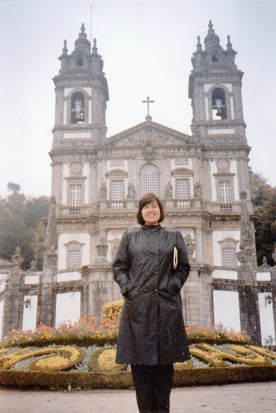 Sherrill at Pilgrimage Church of Bom Jesus
Sherrill at Pilgrimage Church of Bom Jesus Often, we felt as if we were driving from one fairytale place to another, visiting castles and palaces, churches and cloisters, walled cities and Roman temples, gardens and forests. Sometimes, centuries and eras were jumbled together to create astonishing results as we wound through hills and along rivers. Finally, we were back in Lisbon and returned the car. We agreed that Portugal was one of the most beautiful countries we'd visited, but Sherrill would've enjoyed it more if the drivers hadn't been so crazy. After this, we always traveled by train, bus, or boat—no rental cars, except when we traveled with friends who shared the driving and a few times for only part of a trip.
To be continued....
You also might enjoy reading the new bargain-priced e-book edition of my first novel, The Night Action. "The novel careens around the night spots of San Francisco's North Beach and the words seem to fly off the page in the style of Tom Wolfe or the lyrics of Tom Waits." The book is available at Amazon and Barnes and Noble.
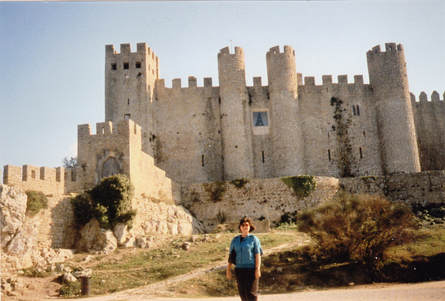
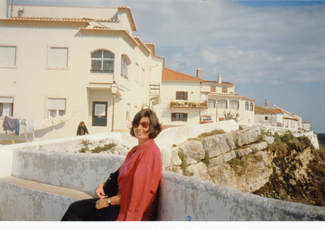
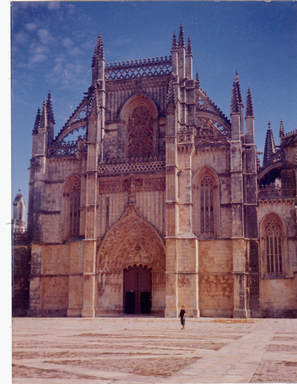
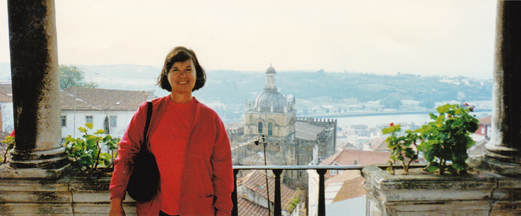
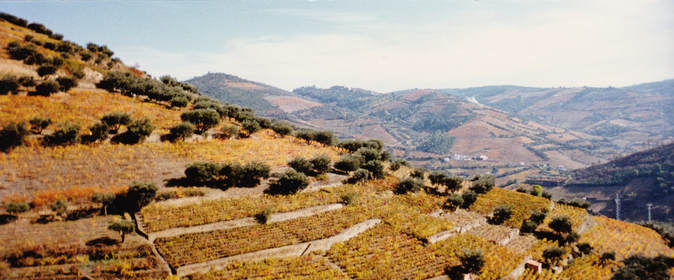
 RSS Feed
RSS Feed